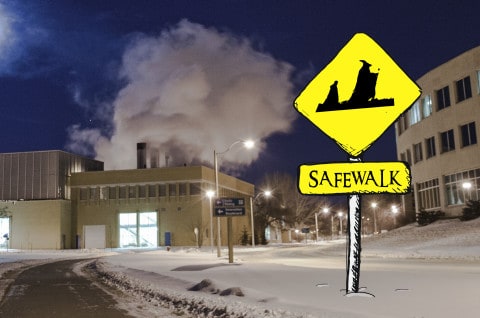Protective Services at the University of Saskatchewan focuses on providing students with peace of mind in knowing that their campus is safe, but widening this conversation to include student feedback has become an increasingly significant focus of late.
With education sessions, student forums and a partnership with the U of S Students’ Union, Protective Services, now more than ever before, is working to build a system of active participation to help create a secure environment for study.
A series of initiatives have been developed to ensure a safe environment and Brian Muchmore, director of Protective Services, believes that in the event of an emergency, preparedness is essential.
“Each college and administrative unit has a local emergency response plan that identifies safe areas and outlines what to do in the event of an emergency; it runs through the certain procedures  that we hope that everyone would follow,” Muchmore said.
that we hope that everyone would follow,” Muchmore said.
Protective Services hosts forums regularly that present an opportunity for students to share what is on their minds in terms of security on campus. The next open meeting is scheduled for Nov. 26 and Protective Services is looking to broaden the response at these sessions.
“We haven’t had a lot of feedback from the student population as a whole, the sessions that we have are probably 25–35 people and that’s great, but it’s such a small sampling size. It’s a big question for us, we wonder what types of community programs we should be adding or continuing,” Muchmore said.
Security drills are also being conducted within each college, coupled with hands-on training and education. Most recently, Edwards School of Business underwent a specified drill and other colleges will follow suit throughout the year.
“We have completed 10 lockdown drills so far, and over 1,600 people have participated in them. Prior to the drills, there are education and awareness sessions for each individual department to ensure that people understand what to do. The plan is, by the end of next year, every college and department will have participated in a similar drill. So far there has been drills in a handful of departments in the College of Arts and Science, agriculture, Edwards School of Business and in dentistry,” Muchmore said.
Another service available to students through Campus Security is the Safewalk initiative, developed in partnership with the USSU.
According to Muchmore, Safewalk is presently underutilized and he encourages students to recognize its value.
“For a student population of about 20,000, we don’t get a lot of calls for Safewalk. I would say the majority of Safewalk users are going from the library back to College Quarter, but that’s not all that it is in place for, you could call and get someone to walk with you to your bus or your car, for example,” Muchmore said.
There are many ways for students to get involved in campus safety, including the AlertUS system, featuring a mobile app that sends real-time updates directly to your phone i n the event of an emergency. Protective Services is also planning to roll out a new program that will simplify the procedure of reporting crimes anonymously.
For Muchmore, the numbers speak for themselves regarding the growing interest in safety awareness on campus.
“To date, there are 2,687 individuals that have registered for the AlertUS mobile app. It’s also available on 6,868 desktop computers and 285 digital signs and there’s also the 20 AlertUS beacons.”
Muchmore emphasizes a need for student understanding and wants the new direction of protection now taking shape to involve the entire campus community.
“We always want to know what staff, students and faculty think, what their perceptions of safety and security on campus are,” he said.
“We try to promote our initiatives by any means possible, and we’re always trying to figure out what it is that students are looking for and what makes them feel safe.”
—
Emily Migchels
Photo Illustration: Jeremy Britz / Graphics Editor